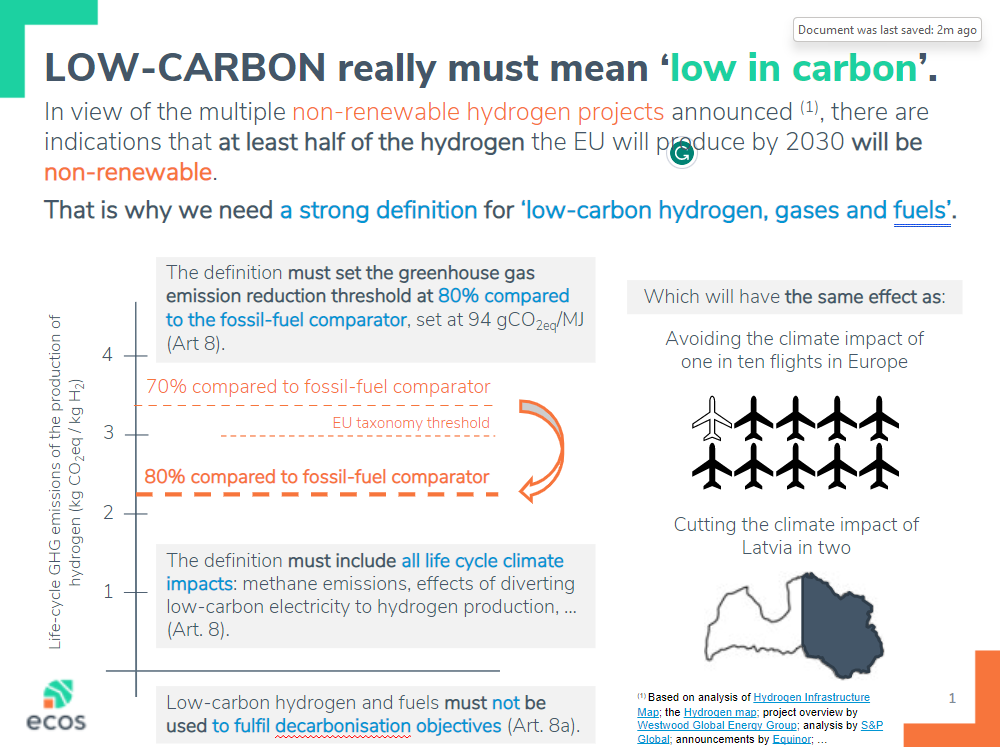Ensuring the right definition of low-carbon hydrogen
Energy ministers of the EU Member States gather on 28 March to agree on how to define ‘low-carbon hydrogen’ in the context of the Gas Directive discussions. This is a key moment for the EU – depending on the level of ambition we can either foster the uptake of truly low-carbon hydrogen with a low climate impact, or lock in non-renewable hydrogen for decades.

The EU Hydrogen Strategy aims to develop clean, renewable hydrogen, produced from wind and solar energy, and compatible with the EU’s 2050 climate neutrality goal. However, investments in renewable hydrogen are currently worryingly insufficient, and in order to cater for the upcoming growing demand, the only way is to actually the EU will need to use more non-renewable hydrogen. In fact, there are firm indications that half of the hydrogen the EU will produce by 2030 will be non-renewable[1], which would lock in fossil gases in the system for years.
The gas and hydrogen industry hopes to get public buy-in for their non-renewable investments by marketing them as ‘low-carbon’. But ‘low-carbon hydrogen’ as defined under the Gas Directive does not equal ‘renewable hydrogen’ defined under the Renewable Energy Directive – and it is renewable hydrogen only that can contribute to our energy transition.
The rather ambiguous term ‘low-carbon hydrogen’ actually refers to hydrogen produced in non-renewable ways. And the different production paths that can be used here result in a true hydrogen rainbow: examples range from electrolysis supplied with nuclear electricity providing the so-called ‘pink’ hydrogen, to steam methane reforming – a very carbon-intense process – combined with carbon capture and storage, resulting in ‘blue’ hydrogen.
‘Low-carbon hydrogen’ is actually a glitch in the energy transition: moving from today’s fossil-based hydrogen to renewable options should happen directly, not via the transitional step of ‘low-carbon hydrogen’, which was only introduced because EU Member States are failing to deploy renewable electricity capacity at the scale that is needed to roll out renewable hydrogen.
The EU energy ministers will now gather to reach an agreement on the Gas Directive including on the definition of ‘low-carbon hydrogen’. They must show enough ambition and set strict limits to the climate impact of the non-renewable hydrogen that will be considered ‘low-carbon’.
The latest proposal of the Gas Directive under revision sets the limit at 3,38 kg CO2eq / kg H2, or ‘at a 70% reduction compared to the fossil fuel comparator, set at 94 g CO2eq / MJ’. And this is not enough. EU Member States must push to set the limit at 2,26 kg CO2eq / kg H2, or at an 80% reduction compared to the fossil fuel comparator.
Here are five good reasons for them to do so:
- It would enable global coherence by bringing the EU closer to other economies which have set similar thresholds[2].
- This is an opportunity to step up compared to the levels already included in the EU Taxonomy, set at 3 kg CO2eq / kg H2 or a 73,4% compared to the fossil fuel comparator. In no way should the Gas Directive backslide!
- Some progressive EU Member States, such as Austria, are already calling for a 90% limit.
- The difference between an 80% and a 70% reduction compared to the fossil fuel comparator will have a tangible impact, especially in view of the multitude of non-renewable hydrogen projects that have been announced. The stricter definition of ‘low-carbon hydrogen’ will make a difference of about 5 million tonnes of CO2 per year by 2030 – half of the climate impact of Latvia.
- And, last but not least, it is technically feasible to respect this stricter limit (see an analysis by ICCT).
The ‘low-carbon hydrogen’ definition needs to set the limit of hydrogen climate impact at 2,26 kg CO2eq / kg H2 or an 80% reduction compared to the fossil fuel comparator. Otherwise, we are looking at decades of non-renewable, polluting hydrogen lock-in.
[1] Based on analysis of Hydrogen Infrastructure Map; the Hydrogen map; project overview by Westwood Global Energy Group; analysis by S&P Global; announcements by Equinor; …
[2] The UK has set the threshold for ‘low-carbon hydrogen’ at 2,4 kg CO2eq / kg H2, while the USA has included 2,5 kg CO2eq / kg H2 set as one of the tier-level for hydrogen production in the Inflation Reduction Act.

 By
By 

